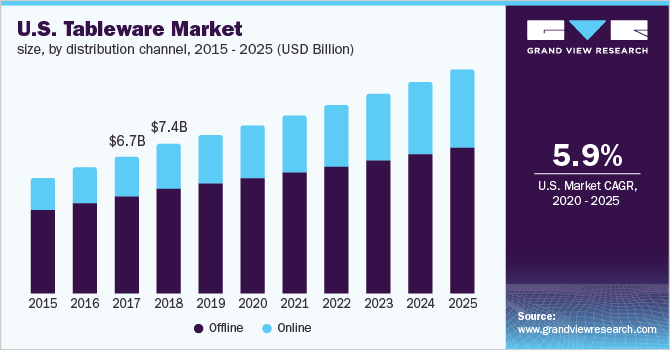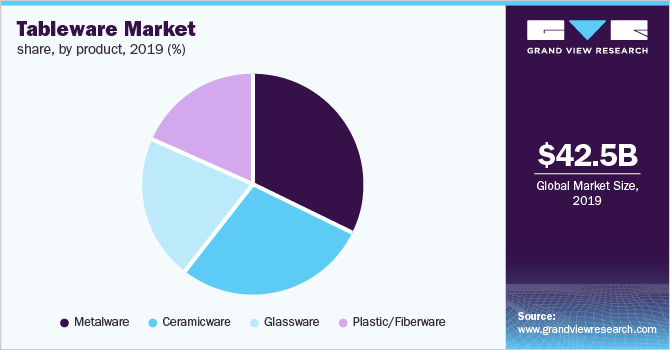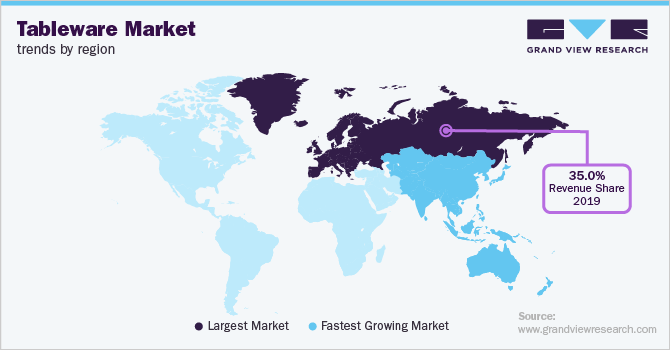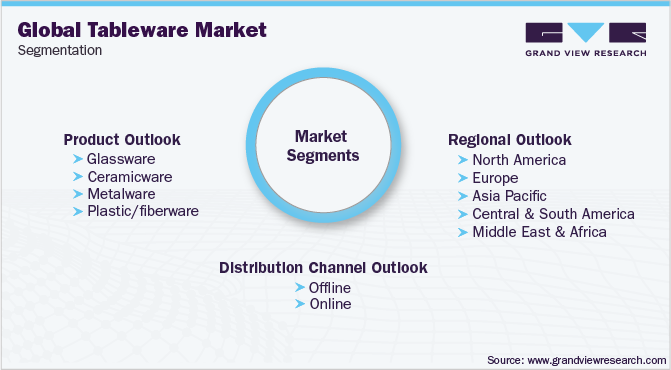- Home
- »
- Homecare & Decor
- »
-
Tableware Market Size, Share Analysis Report, 2020-2025GVR Report cover
![Tableware Market Size, Share & Trends Report]()
Tableware Market (2020 - 2025) Size, Share & Trends Analysis Report By Product (Glassware, Ceramicware, Metalware, Plastic/Fiberware), By Distribution (Offline, Online), And Segment Forecasts
- Report ID: GVR-2-68038-934-0
- Number of Report Pages: 80
- Format: PDF
- Historical Range: 2015 - 2018
- Forecast Period: 2020 - 2025
- Industry: Consumer Goods
- Report Summary
- Table of Contents
- Segmentation
- Methodology
- Download FREE Sample
-
Download Sample Report
Tableware Market Summary
The global tableware market size was estimated at USD 42.52 billion in 2019 and is projected to reach USD 60.40 billion by 2025, growing at a CAGR of 6.0% from 2020 to 2025. Economic growth in emerging countries and development of attractive tableware are the primary factors driving this industry.
Key Market Trends & Insights
- Europe led the market with a share of 35.09% and is anticipated to expand at a significant CAGR during the forecast period.
- Germany accounts for the majority of the share and is expected to register a CAGR of 7.6% over the forecast period.
- By distribution channel, the offline segment dominated the market in 2018 and accounted for 83.0%
- On the basis of product, the metalware segment accounted for the largest share of 33.6% in 2018.
Market Size & Forecast
- 2019 Market Size: USD 42.52 Billion
- 2025 Projected Market Size: USD 60.40 Billion
- CAGR (2020-2025): 6.0%
- Europe: Largest market in 2019
Moreover, rising disposable income, changing lifestyle, and increasing number of houses are driving the demand for the product over the last few years and are expected to propel the market growth in the forecast period.
Furthermore, increasing urbanization is one of the prominent factors as it leads to change in purchasing behavior of the consumer group. Growing residential sector is also propelling the demand for the product. For instance, as per census 2011, in India, the number of houses has increased from 52.06 million to 78.48 million. In other countries, growing population due to migration of consumer group from different countries has increased the number of household consumption, thus propelling the market demand for the product.
For instance, a large population of consumer group from India is shifting to North American countries such as Canada and U.S., which is, in turn, impacting the demand for the product in the region, eventually fueling the global demand. Trend of living in rental house leads the consumers to often change their house, thus consumers prefer to have new tableware in their new house. This is eventually propelling the market demand for the product.
Growing commercial sectors, especially the hospitality sector, are influencing the market growth. In developing countries such as India and China, the hospitality industry is growing at a robust pace and high investment has been made in the sector. For instance, due to increasing startups such as oyo rooms and fabhotels, the number of hotels has increased to a great extent in the last few years. This has led the other industry players in hospitality to upgrade their products and services in order to gain a competitive edge over new entrants, thus fueling the demand in the forecast period.
Usage of disposable plates in various small restaurants due to low cost and no maintenance cost can restrain the market growth in the commercial sector. However, increasing awareness about the health benefits of using stainless steels and aluminum plates for eating can negate the effect of the aforementioned restraining factors.
Tableware Market Trends
With the increasing growth of the real estate industry as well as commercial construction across the globe, the tableware market is likely to witness growth in the coming years. According to the Global Real Estate report published by HSBC, the global real estate industry was valued at USD 228 trillion in 2016, which grew by 5% from 2015. The growing need for new houses because of increasing population growth across the globe is also expected to boost the market.
Moreover, rapid construction in the commercial segment, particularly the hospitality sector, is driving the need for trendy and fancy tableware. According to the Office of National Statistics, the hospitality industry in the UK grew from USD 110.37 billion in 2015 to USD 125.78 billion in 2017. With 289 new hotels and more than 41,000 rooms, the UK is expected to contribute majorly to the growth of the tableware market.
The rising trend of food away from home is creating a lucrative growth opportunity for restaurants and eating joints to propel in the market. The rising number of eating places is developing the need for fancy and trendy tableware for creating a good ambiance and servicing to the customers. In addition, growth in the restaurant industry, owing to the consumers’ desire for convenience, socialization, and high-quality food & service has influenced restaurant owners to invest in modern and quality cooking appliances. According to National Restaurant Association, U.S., there are over 1 million restaurant locations in the country in 2019.
The increasing influx of people to urban areas and varied preferences for different types of food has led to the growing number of cafes, specialty coffee shops, and quick-service restaurants (QSRs). Moreover, rising purchasing power parity and the trend of having food outside the home in emerging countries such as India, China, Indonesia, and Japan are expected to drive the demand for tableware over the forecast period.
Soda ash and silica sand are the key raw materials used in the manufacturing of ceramics. Natural gas is a dominant fuel used in ceramic production. The price and availability of natural gas are the major constraints in the ceramics market.
Storage, weather, and economic growth also affect natural gas prices. Ceramic manufacturing is a high-temperature process, which is a constant economic and environmental challenge for the sector to consume minimum energy. As per the United States Geological Survey, the U.S. natural soda ash production in January 2019, was 957,000 metric tons (t), a 5% decrease from that in the previous month and 4% less than that in January 2018.
Distribution Channel Insights
The offline segment dominated the market in 2018 and accounted for 83.0% share of the total revenue. Increasing demand for the ceramicware segment and perception of issues with the delivery of fragile items are propelling the segment growth. Traditional method of shopping and difference in price in local retail outlets and other wholesale markets are the reasons for the segment growth.
The online segment is anticipated to register a CAGR of 7.5% in the forecast period. Increasing internet penetration in rural areas, faster and trusted delivery by various online portals, and replacement options are driving the segment. Moreover, young working consumer groups with hectic schedule prefer to buy online rather than offline due to easy access and doorstep service. This, in turn, is expected to drive the segment in the coming years.
Product Insights
On the basis of product, the global tableware market is segmented into glassware, metalware, ceramicware, and fiberware. The metalware segment accounted for the largest share of 33.6% in 2018 and is expected to witness significant growth in the near future. A major population prefers to have their dinnerware of metal in countries such as India. Glasses and stands are mostly made of stainless steels, thus fueling the demand for metalware in the forecast period. Demand for metals such as stainless steel and aluminum for dinnerware is increasing due to increasing awareness about the health benefits of metal plates for eating. These are the prominent factors boosting the segment growth.

The ceramicware segment is expected to register a significant CAGR during the forecast period. Changing lifestyle, increasing disposable income, and introduction of low cost ceramicware are propelling the demand for the product. Adoption of the product in developing countries like India and China is expected to drive the segment in the forecast period. The glassware segment also accounts for a significant market share. Usage of the product in European countries and increasing demand for the product in other developing countries are propelling the demand for the segment.
Regional Insights
In 2019, Europe led the market with a share of 35.09% and is anticipated to expand at a significant CAGR during the forecast period. In Europe, Germany accounts for the majority of the share and is expected to register a CAGR of 7.6% over the forecast period. High usage of different types of tableware and increased spending power of the consumer group is driving the market in the region.

Germany is expected to be one of the largest markets in Europe for tableware over the forecast period. The country accounted for a revenue of USD 1,965.1 million in 2018. Increasing urbanization and expenditure on home decoration are driving the demand for tableware in Germany.
The increasing number of households and rising consumer demand for premium cutlery products that serve the purpose as well as complement interiors are driving demand for the product in the market. Increasing growth in commercial sectors of the country with the rising number of restaurants and cafes is leading to the demand for tableware. The presence of a large number of independent and chain cafes is also boosting the demand for the tableware market in the region. As per SCA, there were 28,930 cafes in Germany and 2,160 coffee-focused cafes.
The Asia Pacific is the fastest growing regional market due to high demand from developing countries such as India and China. Changing lifestyles and increasing disposable income are expected to drive the market in the forecast period. The increasing number of houses due to the growing population and rapid development is also a prominent driving factor. Moreover, the increasing number of hotels, pubs, bars and various other options for dining out is fueling the regional market growth in the forecast period.
China emerged as the largest market for tableware in the Asia Pacific and held a market revenue share of 42.1% in 2018. The market dominance can primarily be attributed to the significant expansion of commercial hotels in cities such as Shanghai, Guangzhou, Chengdu, and Suzhou. For instance, according to the blog by eHotelier Pty Limited, as of March 2019, Hilton Worldwide led the hotel construction pipeline in China with about 386 projects and 86,880 rooms, while InterContinental Hotels Group (IHG) ranked second with 314 projects and 72,758 rooms. Thus, the increasing construction of commercial hotels in the country is paving the way for high-end tableware products.
Key Companies & Market Share Insights
Inter ikea group, Tesco.com, Meyer Corporation Group, Cuisinart, Saint-Louis, Mikasa, Raynaud Limoges, Bernardaud, Waterford Wedgewood, and Puiforcat are some of the major market players in the industry. The market presents moderate to high entry barriers due to presence of leading market players and requirement of high setting cost. The market is further driven by innovation in designs, mergers and acquisitions, and joint ventures. For instance, Royal Copenhagen merged with Orrefors/Kosta Boda to form Royal Scandinavia. Joint venture has also become one of the common business strategies. Libbey Inc. came into a partnership with Mexico’s Victrocrisa. This trend has been followed by various European companies as well.
Tableware Market Report Scope
Report Attribute
Details
Market size value in 2020
USD 45.08 billion
Revenue forecast in 2025
USD 60.40 billion
Growth Rate
CAGR of 6.0% from 2020 to 2025
Base year for estimation
2019
Historical data
2015 - 2018
Forecast period
2020 - 2025
Quantitative units
Revenue in USD million/billion and CAGR from 2020 to 2025
Report coverage
Revenue forecast, company ranking, competitive landscape, growth factors, and trends
Segments covered
Product, distribution channel, region
Regional scope
North America; Europe; Asia Pacific; Central & South America; Middle East & Africa
Country scope
U.S.; U.K.; Germany; China; India; Brazil; Saudi Arabia
Key companies profiled
Inter ikea group; Tesco.com; Meyer Corporation Group; Cuisinart; Saint-Louis; Mikasa; Raynaud Limoges; Bernardaud; Waterford Wedgewood; Puiforcat
Customization scope
Free report customization (equivalent up to 8 analysts working days) with purchase. Addition or alteration to country, regional & segment scope.
Pricing and purchase options
Avail customized purchase options to meet your exact research needs. Explore purchase options
Global Tableware Market SegmentationThis report forecasts revenue growth at the global, regional, and country levels and provides an analysis of the latest industry trends in each of the sub-segments from 2015 to 2025. For the purpose of this study, Grand View Research has segmented the global tableware market report on the basis of product, distribution channel, and region.

-
Product Outlook (Revenue, USD Billion, 2015 - 2025)
-
Glassware
-
Ceramicware
-
Metalware
-
Plastic/fiberware
-
-
Distribution Channel Outlook (Revenue, USD Billion, 2015 - 2025)
-
Online
-
Offline
-
-
Regional Outlook (Revenue, USD Billion, 2015 - 2025)
-
North America
-
U.S.
-
-
Europe
-
Germany
-
U.K.
-
-
Asia Pacific
-
China
-
India
-
-
Central & South America
-
Brazil
-
-
MEA
-
Saudi Arabia
-
-
Frequently Asked Questions About This Report
b. The global tableware market size was estimated at USD 42.52 billion in 2019 and is expected to reach USD 45.08 billion in 2020.
b. The global tableware market is expected to grow at a compound annual growth rate of 6.0% from 2019 to 2025 to reach USD 60.40 billion by 2025.
b. Europe dominated the tableware market with a share of 35.0% in 2019. This is attributable to high usage of different types of tableware and increased spending power of consumer groups in the region.
b. Some key players operating in the tableware market include Inter ikea group, Tesco.com, Meyer Corporation Group, Cuisinart, Saint-Louis, Mikasa, Raynaud Limoges, Bernardaud, Waterford Wedgewood, and Puiforcat, among others.
b. Key factors that are driving the market growth include increasing economic growth in emerging countries, rising disposable incomes of consumers, and development of attractive tableware.
Share this report with your colleague or friend.
Need a Tailored Report?
Customize this report to your needs — add regions, segments, or data points, with 20% free customization.

ISO 9001:2015 & 27001:2022 Certified
We are GDPR and CCPA compliant! Your transaction & personal information is safe and secure. For more details, please read our privacy policy.
Trusted market insights - try a free sample
See how our reports are structured and why industry leaders rely on Grand View Research. Get a free sample or ask us to tailor this report to your needs.










